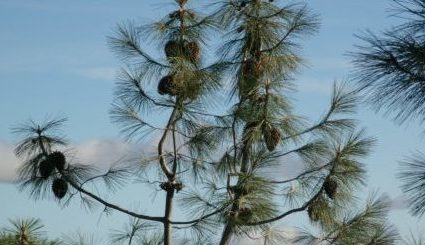The Foothill Pine
 Foothill pine is a handsome evergreen that can grow to 80 feet tall. It’s also called California foothill pine, pinon pine, bull pine, nut pine and gray pine. The California foothill pine thrives in areas with poor soil and little water. The nuts, eaten raw or roasted or even ground into flour with other seeds, were a vital food source for Native Americans. Native Americans also used the pine pitch for medicinal purposes and the branches to fashion utensils and even in basket weaving.
Foothill pine is a handsome evergreen that can grow to 80 feet tall. It’s also called California foothill pine, pinon pine, bull pine, nut pine and gray pine. The California foothill pine thrives in areas with poor soil and little water. The nuts, eaten raw or roasted or even ground into flour with other seeds, were a vital food source for Native Americans. Native Americans also used the pine pitch for medicinal purposes and the branches to fashion utensils and even in basket weaving.
Foothill Pines: Useful Landscaping Trees
While normally a slow-growing tree, regular watering will help the California foothill pine reach half its full height at a much faster rate. Foothill pines are ideal as a windbreak tree because they sway with the wind and are unlikely to be damaged. Windbreaks are especially important in drought-prone areas of our state where high winds can blow away dry soil. They protect smaller plants from strong winds and keep the wind from beating against your home. They also provide some shade for the sunniest side of your house so that you can turn down the air conditioning.
Foothill Pines and Wildlife
California foothill pines provide food and shelter to many varieties of wildlife and even bring butterflies and hummingbirds to your yard. Deer, including mule deer, find its young branches tasty, so you may want to have your trees pruned so that foliage is just out of their reach. Pruning should be done by a landscaper in late fall or winter. Another advantage to pruning is to open up space under the tree for the plants that grow under it in nature.
Songbirds feed on the seeds of the foothill pine, and the tree provides essential winter shelter for birds when other trees lose their leaves. Butterflies also spend the winter in California foothill pine and lay their eggs there in the spring, where the larvae live and spend their pupae stage. Hummingbirds are known for subsisting on nectar, and this pine flowers from late spring into early summer. Hummingbirds also drink tree sap. If you love backyard wildlife watching, consider pines in addition to your bird and butterfly-attracting plants.
The Foothill Pine and Mistletoe
Gray pine dwarf mistletoe, like all varieties of mistletoe, is a parasite, and it’s not the attractive variety that’s become part of holiday lore. Gray pine dwarf mistletoe is unattractive and can harm your foothill pines. If you start to notice curly, dark yellow or reddish-orange masses on your trees, call your landscaper immediately so that they can deal with the infestation before it gets out of control.
Like most trees, for the best placement and growth, foothill pines should be planted by a landscaper. Since the California foothill pine is typically planted in hard, rocky soil, professional equipment is required to dig a hole wide and deep enough for the young pine. Your landscaper can also ensure that young trees receive proper irrigation. Please contact us if you’re interested in foothill pines for your yard.
